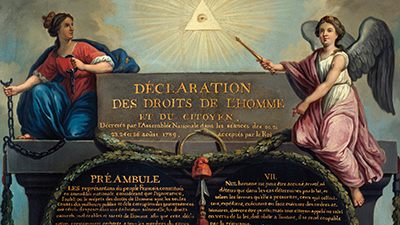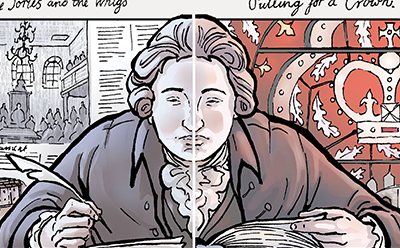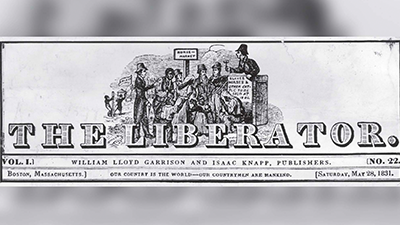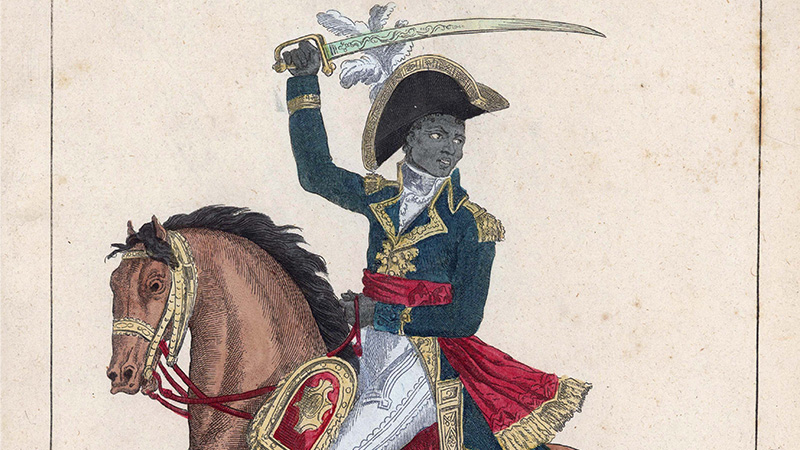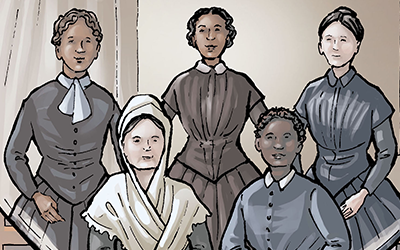The Enlightenment
Teacher Resources
Driving Question: How did intellectual and ideological movements shape the revolutions that swept the Atlantic world from 1750 to 1900 CE?
The Enlightenment was a cultural and intellectual movement in Europe during the late 1600s that emphasized reason, science, and individual rights. Thinkers during this time questioned traditional authority and believed intellectual thought and reason could improve all areas of life. Their ideas about freedom, equality, and government helped inspire revolutions in the late 1700s. However, rising taxes and food prices also pushed people to take action and demand change.
Learning Objectives
- Explain the intellectual and ideological context in which revolutions swept the Atlantic world from 1750 to 1900 CE.
- Explain how the Enlightenment affected societies over time.
- Use graphic biographies to support, extend, or challenge the overarching narratives from this region.
- Analyze primary source documents to evaluate the intellectual and ideological causes of political revolutions from c. 1750 to 1900 CE.
Vocab Terms:
- abolish
- conservative
- gender
- nationalism
- nation-state
- reform
- suffrage
Opener: The Enlightenment
To teach this lesson step, refer to page 3 of the Lesson 5.1 Teaching Guide.
Take a look at these ideas in the Community Forum for suggestions on extending the Enlightenment Quotes activity.
Words have a power that can transcend time. Review these excerpts from famous Enlightenment writers—you might be surprised at how relevant many of their thoughts still are today.
The Enlightenment
To teach this lesson step, refer to page 4 of the Lesson 5.1 Teaching Guide.
Want tips for before-, during-, and after-reading scaffolds? Find reading strategies and more ways to support all learners in our Differentiation Guide.
In what way was The Enlightenment enlightening for people? What were the ideas that helped society progress further?
-
Guiding Questions
-
Before you read
Preview the questions below, and then skim the article. Be sure to look at the section headings and any images.
While you read
Look for answers to these questions:
- How did the Dutch and British influence Enlightenment thought?
- What opinion did Enlightenment thinkers have about slavery?
- What views did Enlightenment thinkers have about progress? How did that affect their views of different societies?
- How did Enlightenment thought impact economic systems?
- How did the Enlightenment help or hurt working people?
After you read
Respond to the following questions:
- To what extent does this article, and your understanding of Enlightenment thinking, explain the causes and effects of the various revolutions in the period from 1750 to 1900?
- So, was the Enlightenment revolutionary? What does the author think? What do you think?
Sovereignty
To teach this lesson step, refer to page 5 of the Lesson 5.1 Teaching Guide.
What does it mean to be free? Does popular sovereignty give people freedom, or does it mean that some have rights while others may not?
-
Guiding Questions
-
Before you read
Preview the questions below, and then skim the article. Be sure to look at the section headings and any images.
While you read
Look for answers to these questions:
- What is a citizen, and how is the idea of popular sovereignty important to creating citizens?
- Thomas Hobbes was an important thinker from this period who wrote a book called Leviathan about popular sovereignty. How does the image from Leviathan express that idea?
- The author argues that sovereignty left people out. What are the examples she gives?
- Beyond just being left out, the author argues that sovereignty for some actually meant that others could lose rights. How does she make this argument?
After you read
Respond to the following questions:
- To what extent does this article explain the causes and effects of the various revolutions in the period from 1750 to 1900?
- How do you think the idea of sovereignty might be used to support revolutionary causes in this period?
Who Benefited?
Enlightenment ideas surrounding rights and sovereignty aimed high, but they also had their limits.
Source Collection: Words of the Enlightenment
To teach this lesson step, refer to page 6 of the Lesson 5.1 Teaching Guide.
Taylor Swift or Enlightenment thinker? Add a fun twist to the Words of the Enlightenment Source Collection with this Community Forum thread.
What inspires a revolution? Perhaps the answer lies in revolutionary thinking—and The Enlightenment was chock-full of it! We recommend using the Quick-Sourcing Tool for this activity.
Graphic Biography: Edmund Burke
To teach this lesson step, refer to page 7 of the Lesson 5.1 Teaching Guide.
Want to learn more about Enlightenment thinkers like Burke? Read Bennett Sherry’s blog, “Give me cereal, or you get death!”
Is it possible to be both liberal and conservative at the same time? Edmund Burke was. In this graphic biography, you will find out how!
-
Guiding Questions
-
Before you read
Skim the full comic, paying attention to things like prominent colors, shapes, and types of text and fonts. How do you know where to start and which direction to read? What’s in the gutters (the space between panels)? Who is the focus of the comic? What big questions do you have?
While you read
Look for answers to these questions:
- When and where was Edmund Burke born? Who ruled the place where he was born?
- What was the major political contest in Britain during this period? What did each side believe?
- In what ways was Burke a liberal? In what ways was he a conservative?
- What were the events that made Burke fear too rapid change and too much democracy?
- How does the artist use art and design to demonstrate Burke’s position as both a liberal and a conservative?
After you read
Respond to the following questions:
- We generally speak of political revolutions in this period as bringing more liberties and being a good thing. Does Burke’s biography challenge that assumption? How?
- How could the rise of liberalism in this period also lead to the rise of political conservatism? Does this biography provide any clues to help you to answer this question?
Why Was Slavery Abolished? Three Theories
To teach this lesson step, refer to page 8 of the Lesson 5.1 Teaching Guide.
It took time for slavery to be abolished—but why? This article examines three theories about the end of slavery in the Atlantic world.
-
Guiding Questions
-
Before you read
Preview the questions below, and then skim the article. Be sure to look at the section headings and any images.
While you read
Look for answers to these questions:
- Which countries were among the first to abolish the slave trade?
- Which countries abolished slavery later?
- How might capitalism have helped end slavery?
- How might changing morality have helped end slavery?
- How might networks of Africans and descendants of Africans have helped end slavery?
- Does the author argue that slavery actually ended when it became illegal? Use evidence from the text to back up your answer.
After you read
Respond to the following questions:
- In what ways did Enlightenment ideas and religious ideals influence the abolition of slavery?
Origins and Impact of Nationalism
To teach this lesson step, refer to page 9 of the Lesson 5.1 Teaching Guide.
Nationalism grew across many parts of the world throughout the long nineteenth century. But why? This article may provide some answers.
-
Guiding Questions
-
Before you read
Preview the questions below, and then skim the article. Be sure to look at the section headings and any images.
While your read
Look for answers to these questions:
- What is a nation? Are nations natural or biological?
- Why does the author describe nations as “imagined communities”?
- How did French military victories contribute to the rise of nationalism in France and elsewhere?
- In what context did nationalism take hold in Europe and in the Americas?
- What factors helped nationalism take hold in Germany and Italy?
After you read
Respond to the following questions:
- To what extent does this article explain the intellectual and ideological context in which revolutions swept the Atlantic world from 1750 to 1900?
- What is the author’s main argument about nationalism? Do you find it convincing? Why or why not?
- What are some of the ways in which nationalism helped liberate people or bring about positive political change in this era? Can you predict any potential problems or challenges that nationalism might also bring? If so, what are they?
Suffrage, Slavery, and Serfdom
To teach this lesson step, refer to page 10 of the Lesson 5.1 Teaching Guide.
Check out our Comparison One Pager to learn more about how we approach this historical thinking practice.
The Enlightenment is often viewed as a revolutionary philosophical movement that inspired revolution and reform, but how much credit should we give it?
-
Guiding Questions
-
Before you read
Preview the questions below, and then skim the article. Be sure to look at the section headings and any images.
While you read
Look for answers to these questions:
- How did women use Enlightenment and revolutionary ideas to fight for reform?
- How did abolitionists use Enlightenment and revolutionary ideas to fight for reform?
- How did Enlightenment ideas influence reforms to serfdom?
- How is the fight for women’s rights and the abolition of slavery and serfdom more complex than just saying these were products of Enlightenment thinking? Provide at least two examples.
After you read
Respond to these questions:
- How successful were these Enlightenment-inspired movements for equal rights? Provide specific examples to support your response.
- How did the Enlightenment impact social interactions and organization from c. 1750 to 1900 CE?
Closer: The Enlightenment
To teach this lesson step, refer to page 13 of the Lesson 5.1 Teaching Guide.
Wanting to include more women in history class? This blog post is full of ideas!
Harriet Forten Purvis not only fought the institution of slavery, but also fought the male-dominated institutions that, during her time, denied her the right to vote.
-
Guiding Questions
-
Before you read
Skim the full comic, paying attention to things like prominent colors, shapes, and types of text and fonts. How do you know where to start and which direction to read? What’s in the gutters (the space between panels)? Who is the focus of the comic? What big questions do you have?
While you read
Look for answers to these questions:
- What was Harriet Forten Purvis’ family and community like as a child?
- What was the Philadelphia Female Anti-Slavery Society, and what happened when they organized a national conference in 1838?
- How else did Purvis and her husband fight against slavery and discrimination?
- What other reform movement did Purvis work for, and what were the results of their struggle?
- The first letter of Purvis’ name in the title is formed by two women, one black, one white, holding hands. These same women are shown in the last panel, but separated. What is the artist communicating here?
After you read
Respond to the following questions:
- To what extent does this article explain how revolutionary changes of this era impacted social hierarchies?
- How does this biography of Harriet Forten Purvis support, extend, or challenge what you have learned about social transformations and their limits during the long nineteenth century?



